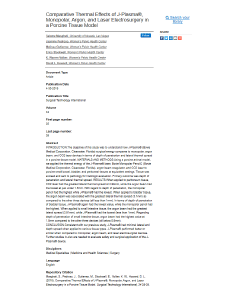Comparative Thermal Effects of J-Plasma®, Monopolar, Argon, and Laser Electrosurgery in a Porcine Tissue Model
ITEM TYPE:
Journal Article
AUTHORS:
Salome Masghati, MD, Jasmine Pedroso, MD, MPH, Melissa Gutierrez, MD, Erica Stockwell, DO, MBA, K. Warren Volker, MD, PhD, David L. Howard, MD, PhD
ABSTRACT:
Introduction: The objective of this study was to understand how J-Plasma (Bovie® Medical Corporation, Clearwater, Florida) surgical energy compares to monopolar, argon beam, and CO2 laser devices in terms of depth of penetration and lateral thermal spread in a porcine tissue model.
Materials and methods: Using a porcine animal model, we applied the thermal energy of the J-Plasma laser, Bovie Monopolar Pencil™ (Bovie Medical Corporation, Clearwater, Florida), argon beam coagulator, and CO2 laser to porcine small bowel, bladder, and peritoneal tissues at equivalent settings. Tissue was excised and sent to pathology for histologic evaluation. Primary outcome was depth of penetration and lateral thermal spread.
Results: When applied to peritoneum tissue, CO2 laser had the greatest lateral thermal spread at 2.99mm, while the argon beam had the lowest at just under 1.5mm. With regard to depth of penetration, the monopolar pencil had the highest while J-Plasma had the lowest. When applied to bladder tissue, the argon beam was associated with the greatest lateral thermal spread (3.1mm) as compared to the other three devices (all less than 1mm). In terms of depth of penetration of bladder tissue, J-Plasma again had the lowest value, while the monopolar pencil had the highest. When applied to small intestine tissue, the argon beam had the greatest lateral spread (3.51mm), while J-Plasma had the lowest (less than 1mm). Regarding depth of penetration of small intestine tissue, argon beam had the highest value at 1.8mm compared to the other three devices (all below 0.6mm).
Conclusion: Consistent with our previous study, J-Plasma had minimal lateral and depth spread when applied to various tissue types. J-Plasma performed better or similar when compared to monopolar, argon beam, and laser electrosurgical devices. Further studies in-vivo are needed to evaluate safety and surgical application of the J-Plasma device.
APYX® MEDICAL DISCLOSURES:
FINANCIAL & CONTENT DISCLOSURE
There are no disclosures to report. The opinions contained herein are those of the authors(s) and do not necessarily represent the official position or policies of Apyx Medical, Inc.
MANUFACTURING DISCLOSURE
Apyx Medical manufactures and owns the Renuvion®/J-Plasma technology discussed in this article.
INDICATIONS FOR USE & INTENDED USE DISCLOSURES
- The Renuvion Precise, Precise Open, and J-Plasma Handpieces are intended to be used with compatible electrosurgical generators for the delivery of radiofrequency energy and/or helium plasma for cutting, coagulation, and ablation of soft tissue during open surgical procedures.
- Apyx Medical wants to present to you with current scientific discourse.
RISKS
- Risk associated with the use of the device may include: Helium embolism into the surgical site due to inadvertent introduction into the venous or arterial blood supply system, unintended burns (deep or superficial), pneumothorax, temporary or permanent nerve injury, ischemia, fibrosis, infection, pain, discomfort, gas buildup resulting in temporary and transient crepitus or pain, bleeding, hematoma, seroma, subcutaneous induration, pigmentation changes, increased healing time, and/or unsatisfactory scarring. There may be additional risks associated with the use of other devices along with Renuvion/J-Plasma and there may be an increased risk for patients who have undergone prior surgical or aesthetic procedures in the treatment area.
As with any procedure, individual results may vary. As with all energy devices there are inherent risks associated with its use, refer to the IFU for further information.



